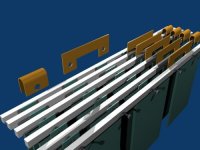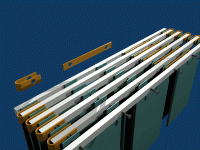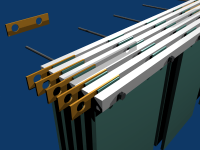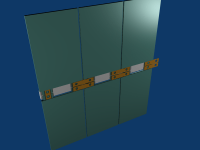Regarding building the cells into packs, I had some thoughts here:
http://www.endless-sphere.com/forums/viewtopic.php?p=497517#p497517
that may not apply to your cells, but might be helpful:
*****************************************
After some thought and various pics around the web and ES of cells and terminations, I think that what I seem to recall was the EIG NMC pouches appear to have the best easily-stackable method. I am not totally sure how they work, and I cannot now find any of the pictures I have seen over the last months that were labelled as of those types, just one that I think might be, so I might be mixing up different manufacturer's methods into a mishmash that might nto actually work. :? Lots of the pics were very low resolution so I am not certain of details, just guessing based on stuff I do know about various ways things are commonly put together.
The only person on here that I'm sure could verify this is Jay64, as he actually has some of these cells, presumably including the hardware I think I am remembering.
Basically, I think there are short brass (?) plates welded by some method to the actual cell tabs. These plates are 90-degree bends, with two holes in the part perpendicular to the cell itself. I can't find the pic of the cells that looked like this now, but I thougth it was on ES in one of the A123 threads. Might be a "lost image" after the problems this summer.

The cells lay flat in trays (plastic?) with the bent plates down over a set of what must be molded-in threaded "nutserts" in the end of the tray. (couldn't see the actual trays or nutserts in the pics, but it's the only way I can imagine it workable).
There are alignment holes in all the trays so they can be easily stacked and bolted together thru the corners or edges (not totally sure about this, but it would make sense).
Once your series cells are all stacked up, angled bussbars are bolted thru the plates on the tabs into the trays. Angled so that they connect the + of one cell to the - of the next without flip-flopping every other cell. I'm not sure how easy this would be to do without potential shorts on the cells, but I saved an enlarged version of part of a pic of a pack that shows what I think is this method:
Anyway, if you don't have room for a wide stack of cells you could bolt a plate across several stacks of these things and tthen bolt cables or busbars between each stack for series connections.
Paralleling them is easy, as you just use busbars across all the negs and other busbars across all the positives, and can even just use extra-wide ones to bolt across sets of them to create extra pack stiffness.
Because the trays are doing all the supporting, there should be no stress on the tabs at all, unlike some of the other methods I've seen proposed that would require a box be built around the pouches that supports them as a group, that is then bolted to all the cell interconnect hardware.
The only real problem I see with the whole idea is that I can only imagine injection-molding as the way to make the trays including nutserts/etc., and that is probably going to be pretty expensive per-tray unless someone does it as a venture to sell them to all those people with the A123 pouches.
Hopefully this all makes sense without a drawing, but I can try to sketch one up if it doesn't.








